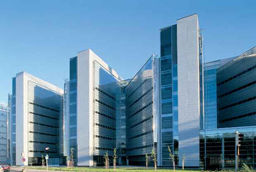IP Cameras
An Internet Protocol Camera, commonly known as IP camera is a combination of a camera and computer as a unit connected via a network. It is a type of digital video camera which is commonly deployed for surveillance activities and has the capability of sending and receiving data via computer and internet. It is a fact that web cameras are also eligible to be called as IP cameras, but usually those cameras deployed in surveillance activities are known as IP network cameras. Since, IP security cameras work through a network based platform, they are also referred as Network Cameras.
Components involved in an IP based security Camera are lens, image sensor, a processor and a memory cache. The processors are used for image processing, compression, video analysis and networking functionalities. The memory cache is used for storing network camera’s firmware and also for temporarily recording of video sequences.
A network IP camera has also an assigned IP address in a similar way, like a computer and can work or can be placed wherever a network connection is available. The main difference in between a web camera (as referred earlier in this article) and a IP surveillance camera is that a web camera needs a computer connection to operate via an USB or IEEE 1394 port and in order to use it a software must be installed on the Personnel Computer. Moreover, an IP based security camera can provide web server activities, FTP and email functionalities and also includes IP network and security protocols.
With the help of IP security camera, there is a flexibility of sending a video based on configuration. The video can be sent over an IP network for live viewing or/and for recording either continuously, in scheduled times or on an event or on request of the surveillance administrator or an authorized user. Using various network protocols, the captured images can be streamed as Motion JPEG, MPEG4 and also through H.264 video which uses compression format technology.
Security surveillance Cameras based on IP, also facilitate Intelligent Video Analytics features like video motion detection, audio detection, active tampering alarm and auto tracking feature. In order to connect to external devices such as relays and sensors, IP based monitoring cameras are also offered with input/output ports that facilitate this connectivity. All IP cameras delivered in the markets these days are being presented with PoE feature which is Power on Ethernet. That is the same cable which connects it to the PoE switch and internet connectivity will also facilitate power supply, for running the camera, in the absence of reliable power source connectivity.
Types of IP Cameras
IP cameras are formerly classified into two categories which are centralized storage based IP security cameras and decentralized storage based IP surveillance cameras. In a centralized storage, the network camera captures a video and sends it via a network to a video recorder, which acts as a storage server. A decentralized network IP camera will have a storage media embedded in it like a memory card and this media stores all the video which has been captured by an IP camera.
IP based surveillance cameras also known as Network cameras can be classified in terms of their usage for indoor and outdoor activities. It is a fact that outdoor IP cameras have an auto IRIS lens for regulating the amount of light reaching the image sensor when it is exposed to. Moreover, an outdoor surveillance camera needs an extra housing such as a protective dome. The Indoor IP cameras are also required to have protective enclosures in order to protect them from dust, humidity, vandalism and tampering.
Indoor IP surveillance cameras and Outdoor surveillance cameras based on IP in combined format are classified into Fixed IP cameras, fixed dome IP cameras, PTZ and PTZ dome network cameras.
Fixed IP cameras – Fixed IP security Cameras are offered with fixed or varifocal lens and are offered with fixed field of view, once they are mounted. They do have the ability to turn as per the need or the motion. But they offer crystal clear vision of the image while monitoring in their surveillance area. Fixed cameras are generally deployed where crystal clear images have to be captured, without the need of tilting or panning. They are ideal to be deployed at the entrance of shopping malls, banks, government offices and for home surveillance.
Fixed Dome IP Cameras – Fixed Dome IP surveillance cameras are those security cameras which have fixed focus and need to be housed inside a dome. The main need of these fixed dome cameras arises if the deployment is necessary outdoors. With the robust housing the IP dome camera will never reveal its point of focus of direction and so it can remain under cover. Moreover, fixed dome cameras are equipped with exchangeable lens.
PTZ IP Cameras – Pan, Tilt and Zoom PTZ cameras have the ability to manually or automatically pan, tilt and zoom in and out of an area or object. All IP based PTZ cameras facilitate video transmission through a network cable. The features which are incorporated in a PTZ camera are:
- Electronic image stabilization – PTZ cameras are available with zoom factors which are above 20x and can withstand vibrations and motion caused by traffic or wind, due to EIS means electronic image stabilization. This feature also reduces the file size of the compressed image and thereby saving valuable storage space.
- Masking of 3D privacy – This feature is available on selective vendor related PTZ cameras where masking or blockage of scenes from being viewed or recorded is possible. This masking is also maintained, if the camera is panned or tilted or zoomed.
- Preset Positions – PTZ cameras allow the programming of preset positions which can be in the range of 20 to 100. With the help of preset position, the surveillance camera administrator can surf in a quick way from one position to another.
- E-flip – E-Flip is a camera feature, which allows the image to be rotated in 180 degrees angle. This facilitates to capture a person, passing under the camera and have upside down image functionality. As this is an automated camera feature, this goes unnoticed by the operator.
- Auto-flip – In order to stop the cameras from making a continuous circular movement, a mechanical stop prevents the cameras from taking 360 degrees of continuous pan. With the auto flip feature, a PTZ IP surveillance camera can instantly flip the camera head for up to 180 degrees and will continue to pan beyond its zero point. This allows the camera to follow any passing person or an object in any direction.
- Auto Tracking – with the help of an auto tracking feature, which is an intelligent video functionality, a person or vehicle which is moving can be automatically detected. This feature helps out a person, where there in unmanned video surveillance situations. With this feature unwanted recording of zero activity is avoided and thus the storage space can be saved.
Mechanical PTZ Cameras – Mechanical PTZ security cameras have moving parts and work under the supervision of an operator and they can be mounted on a ceiling or a platform. There is an optical zoom on PTZ camera which will be in the range of 10x to 26x.
Non-Mechanical PTZ cameras – These non-mechanical PTZ surveillance cameras utilize megapixel image sensor which offers flexibility for the admin to zoom on a particular scene without image resolution loss. This can be achieved by putting the resolution in VGA format, which allows the camera to capture a much higher resolution image. Actually the image is captured in megapixel resolution, but the VGA resolution of the overview of the image is allowed.
PTZ dome cameras – All PTZ dome cameras offer features which are supposed to be delivered by PTZ IP cameras. The only major difference will be that the cameras will be placed in the compartment structure and will be delivering the same work functions. A PTZ dome camera also presents mechanical robustness for nonstop operation in a guard tour functional mode, whereby the camera robotically moves from one present location to the next in a pre-determined sort or at random.
Day and Night functionality – IP surveillance cameras, no matter what model they are, offer day and night functionality, which can be utilized in outdoor and indoor environments. In the night vision, IP camera delivers black/white images, while in day time, they deliver colored images. The light diminish below a permissible level, will be sensed by the sensor in the IP security camera and so it offers night mode and will offer IR light to deliver high quality of B/W images.
IR light is in between 700nm and 1000nm and is not detectable by the human eye, but the camera sensor can detect and utilize it. In the presence of daylight there is an IR cut filter which stops the night mode from activating. As the IR light is filtered out, the distorted colors are absent and so colored images are captured by the Network camera. As soon as the camera experiences night environment, the IR cut filter gets automatically removed and so B/W images are produced. Day and night network cameras are utilized in low light video surveillance environments, covert surveillance and where the installation is done on such a platform, where the light availability cannot be predicted, such as mines and caves.
Megapixel IP cameras – These cameras offer the best and the most, from among the IP based cameras and are available in fixed and dome models. A mega pixel camera offers images with one million or more pixels. This is at least two times better pixels, when compared to analog cameras. Mega pixel cameras offers higher resolution image and also help in identifying people and objects. They can be used to cover large scene and can offer undisputed image resolution, which a non megapixel camera cannot. Moreover, these cameras are not light sensitive and have inbuilt H.264 video compression standard.
Advantages of IP camera surveillance
- Through network IP camera surveillance, a two way audio communication is possible via a single network cable and this allows the users to communicate while on live monitoring.
- High image resolution can be achieved by the network camera surveillance, if a megapixel network camera is deployed.
- IP based surveillance cameras especially wireless can be moved on an IP network to any point.
- An IP camera can facilitate intelligent video analytics and that will offer distributed intelligence.
- A Single network cable can facilitate transmission of commands for a PTZ camera like panning, tilting and zooming.
- IP based camera transfer data with encryption and authentication methods.
- Remote accessibility can be achieved by a network camera as live videos monitoring and video recording can take place off the location of surveillance and can also be viewed on smart phones and iPads, if apt software is available.
- In case the Internet Protocol camera functionality supports wireless activity, then the surveillance can be carried out through wireless interface. An apt router has to be installed and it will be helping out the surveillance IP camera to deliver the goods.
- Power over Ethernet function will make things simpler while installation and management. Instead of using a line for power and a line for video streaming, both can be done through a single line interface. This feature is a highlight of these video monitoring camera and is absent in analog cameras.
Disadvantages of IP camera surveillance
- The fact is that IP cameras are available for high cost and so the installation of them for surveillance purpose can prove as a costly affair.
- High network bandwidth is required for streaming of videos.
- Technical expertise is required in installing and managing these security cameras.
- If in case the network IP camera is delivering its duties on an internet platform, which is a public platform, then it has the threat of being hacked.
Tips to be followed while selecting an IP camera
There are certain guidelines, which have to be followed when selecting an Internet protocol based security camera and those are lined up below:
- Surveillance goal – First and foremost is to stay clear on the video surveillance feature and conclude whether it needs to be in high detail or just in an overview format. If there is a need for high detail surveillance, then the selection of megapixel network cameras makes sense. If the surveillance just needs to be in an overview format, then a PTZ camera can work for the scenario.
- Area to be monitored – While going for an IP camera deployment, it is better to go for the review of the area to be monitored at first. Then check whether the monitoring areas are close to each other or are far off and then go for the selection of the Video monitoring camera.
- Indoor or outdoor monitoring – light sensitivity plays a vital role while going for an indoor or outdoor cameras. Since, there is no industry standard in measuring light sensitivity, the LUX measurements marked on these security cameras must be considered. The second vital thing to make a note off is to select a dome camera or a without a dome camera. Mostly, indoor related surveillance can be carried out without a dome IP surveillance camera. But an outdoor surveillance must need a dome camera, in order to protect it from vandalism, weather effects and any kind of human interference.
- Factors such as image quality, resolution, compression and audio support are a must while going for an IP camera selection.
- Open interface and Video management software – Managing videos is as important as capturing them and so while selecting a monitoring camera based on IP, one needs to check out whether it supports the available Video Management Software and must also be compatible to the further versions. An IP camera, which is offered as an open interface to the consumers will be a much preferred choice by most. It should integrate with present systems and must support all application software and management software’s such as video analysis.
- Network functionalities – IP cameras should posses PoE, HTTPS encryption of video streams, IP address filtering, and IPV6 support.
Things to be noted while installing a IP camera
To achieve the best results of high quality video surveillance, one needs to place the video surveillance camera in the best place & environment.
Type of surveillance – The foremost thing is to go according to the need of the enterprise or if it is regarding home surveillance. If just an overview of surveillance is required, then go for the apt network camera, which offers it as so. If movement of objects and people is required to be tracked then go for the camera which best fits into the task.
Always avoid direct sunlight – while placing a surveillance camera in position. The heat generated by sun light can burn the inner hardware and so this can lead to malfunctioning. However, most of the dome cameras are coming up with domes which are weather proof. At the same time, by repositioning or perfectly position of IP security camera will also eliminate the backlight problems.
Be sure about the dynamic range of a camera – Always being sure about the dynamic range of the cameras and if necessary place them at a vantage point, where the camera can offer better results.
Legally permitted – while installing a best IP camera, make sure that the country or the state are allowing video surveillance. Sometimes certain areas like border regions can have restrictions on security surveillance and if the enterprise, home or the surveillance area fall into its range, then legal problems may arise.
DNF Security
DNF Security is a subsidiary of Dynamic Network Factory headquartered in the heart of Sillicon Valley, CA.
©2020 Dynamic Network Factory
Follow us


